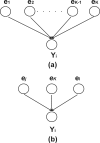Bayesian Orthogonal Least Squares (BOLS) algorithm for reverse engineering of gene regulatory networks
- PMID: 17626641
- PMCID: PMC1959566
- DOI: 10.1186/1471-2105-8-251
Bayesian Orthogonal Least Squares (BOLS) algorithm for reverse engineering of gene regulatory networks
Abstract
Background: A reverse engineering of gene regulatory network with large number of genes and limited number of experimental data points is a computationally challenging task. In particular, reverse engineering using linear systems is an under-determined and ill conditioned problem, i.e. the amount of microarray data is limited and the solution is very sensitive to noise in the data. Therefore, the reverse engineering of gene regulatory networks with large number of genes and limited number of data points requires rigorous optimization algorithm.
Results: This study presents a novel algorithm for reverse engineering with linear systems. The proposed algorithm is a combination of the orthogonal least squares, second order derivative for network pruning, and Bayesian model comparison. In this study, the entire network is decomposed into a set of small networks that are defined as unit networks. The algorithm provides each unit network with P(D|Hi), which is used as confidence level. The unit network with higher P(D|Hi) has a higher confidence such that the unit network is correctly elucidated. Thus, the proposed algorithm is able to locate true positive interactions using P(D|Hi), which is a unique property of the proposed algorithm. The algorithm is evaluated with synthetic and Saccharomyces cerevisiae expression data using the dynamic Bayesian network. With synthetic data, it is shown that the performance of the algorithm depends on the number of genes, noise level, and the number of data points. With Yeast expression data, it is shown that there is remarkable number of known physical or genetic events among all interactions elucidated by the proposed algorithm. The performance of the algorithm is compared with Sparse Bayesian Learning algorithm using both synthetic and Saccharomyces cerevisiae expression data sets. The comparison experiments show that the algorithm produces sparser solutions with less false positives than Sparse Bayesian Learning algorithm.
Conclusion: From our evaluation experiments, we draw the conclusion as follows: 1) Simulation results show that the algorithm can be used to elucidate gene regulatory networks using limited number of experimental data points. 2) Simulation results also show that the algorithm is able to handle the problem with noisy data. 3) The experiment with Yeast expression data shows that the proposed algorithm reliably elucidates known physical or genetic events. 4) The comparison experiments show that the algorithm more efficiently performs than Sparse Bayesian Learning algorithm with noisy and limited number of data.
Figures







Similar articles
-
A new dynamic Bayesian network (DBN) approach for identifying gene regulatory networks from time course microarray data.Bioinformatics. 2005 Jan 1;21(1):71-9. doi: 10.1093/bioinformatics/bth463. Epub 2004 Aug 12. Bioinformatics. 2005. PMID: 15308537
-
Sensitivity and specificity of inferring genetic regulatory interactions from microarray experiments with dynamic Bayesian networks.Bioinformatics. 2003 Nov 22;19(17):2271-82. doi: 10.1093/bioinformatics/btg313. Bioinformatics. 2003. PMID: 14630656
-
Reconstructing genetic networks from time ordered gene expression data using Bayesian method with global search algorithm.J Bioinform Comput Biol. 2004 Sep;2(3):441-58. doi: 10.1142/s0219720004000673. J Bioinform Comput Biol. 2004. PMID: 15359420
-
Inferring network interactions within a cell.Brief Bioinform. 2005 Dec;6(4):380-9. doi: 10.1093/bib/6.4.380. Brief Bioinform. 2005. PMID: 16420736 Review.
-
Comparison of reverse-engineering methods using an in silico network.Ann N Y Acad Sci. 2007 Dec;1115:73-89. doi: 10.1196/annals.1407.006. Epub 2007 Oct 9. Ann N Y Acad Sci. 2007. PMID: 17925358 Review.
Cited by
-
Comparative analysis of cis-regulation following stroke and seizures in subspaces of conserved eigensystems.BMC Syst Biol. 2010 Jun 17;4:86. doi: 10.1186/1752-0509-4-86. BMC Syst Biol. 2010. PMID: 20565733 Free PMC article.
References
Publication types
MeSH terms
Substances
LinkOut - more resources
Full Text Sources
Molecular Biology Databases

